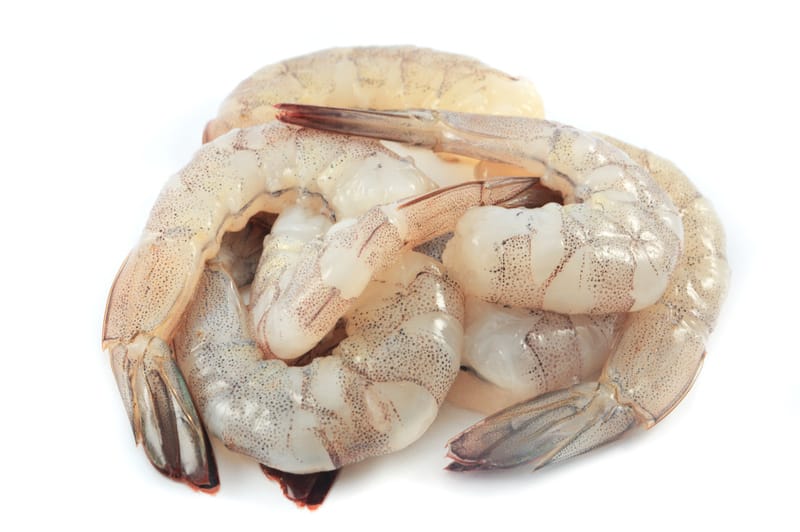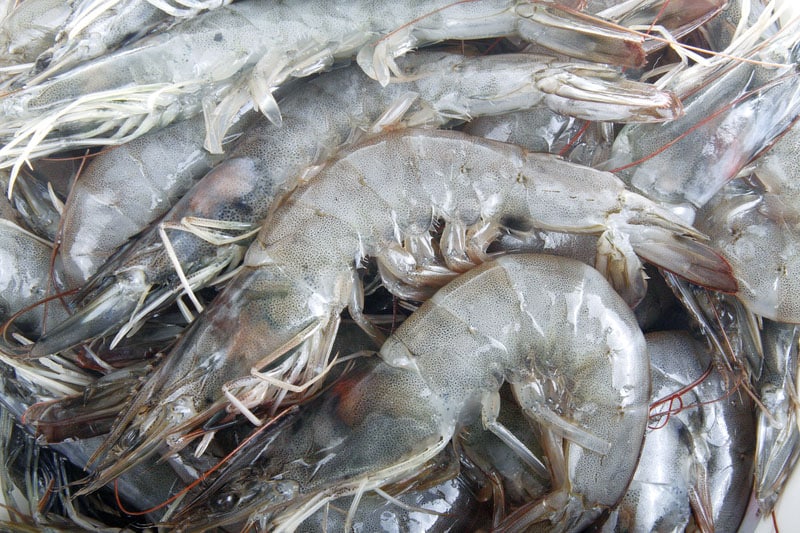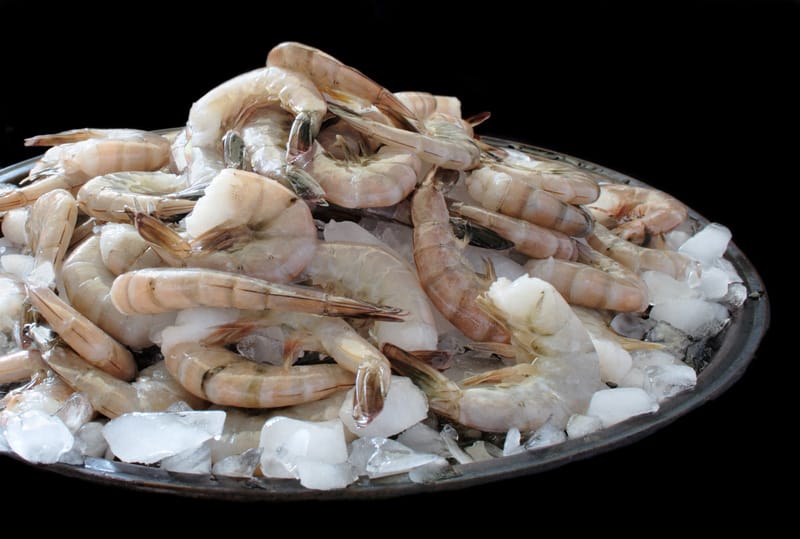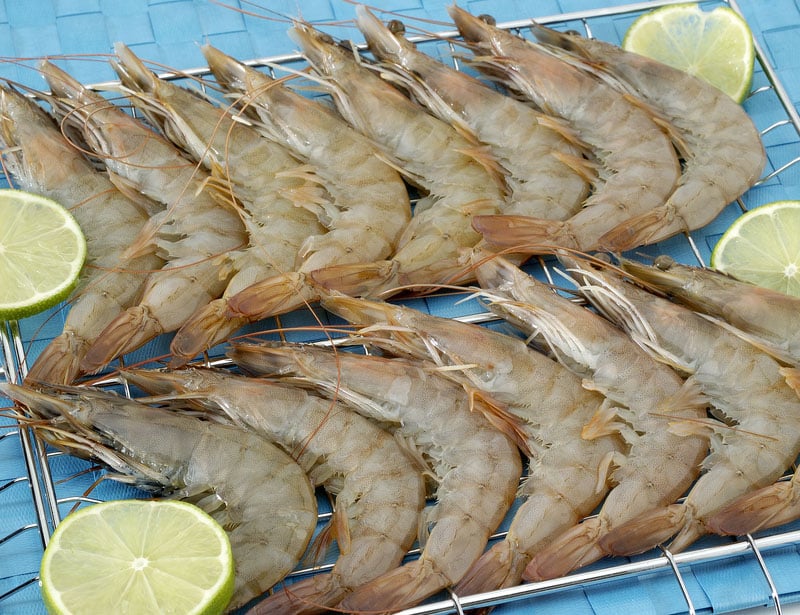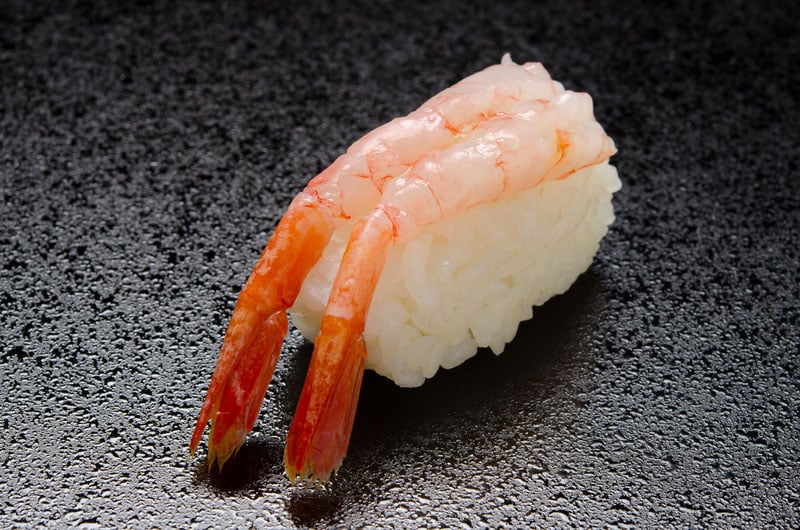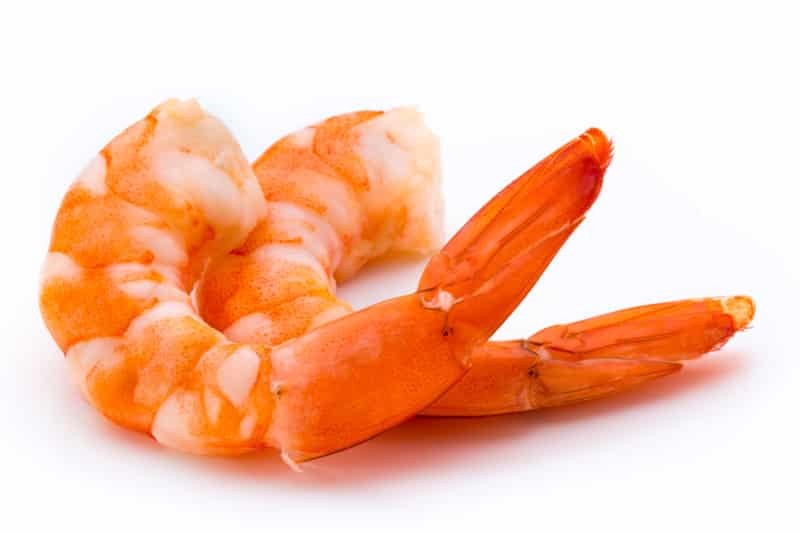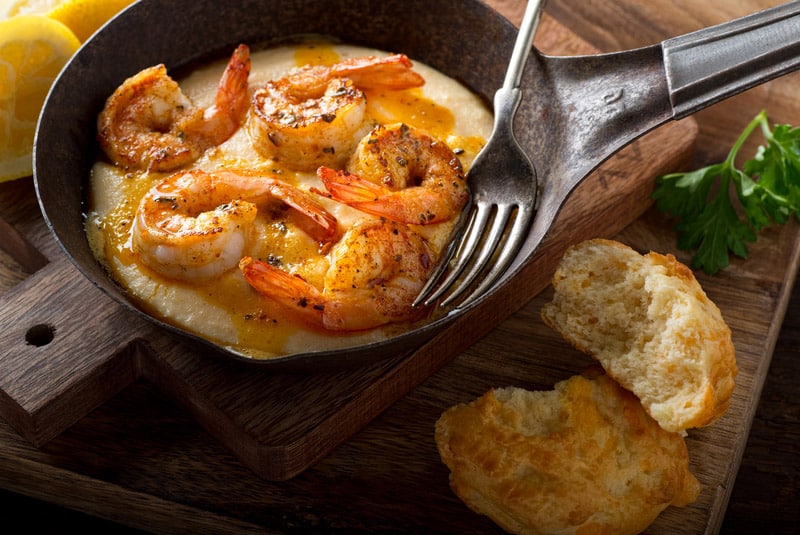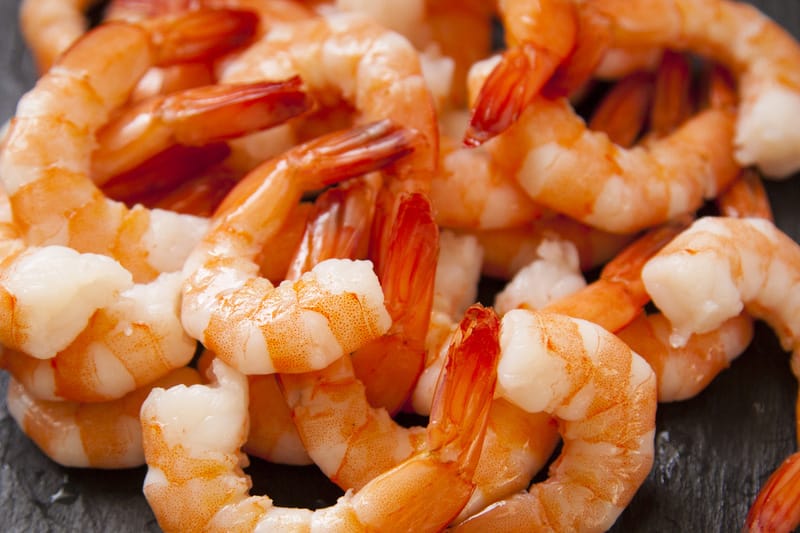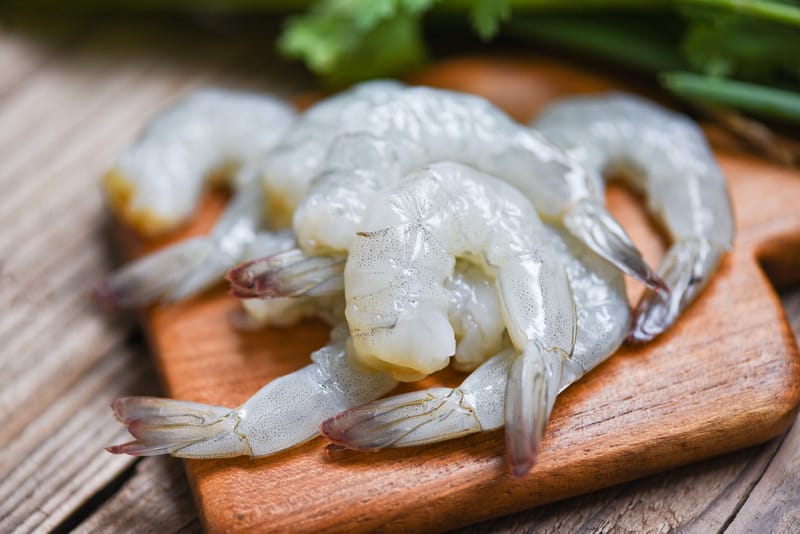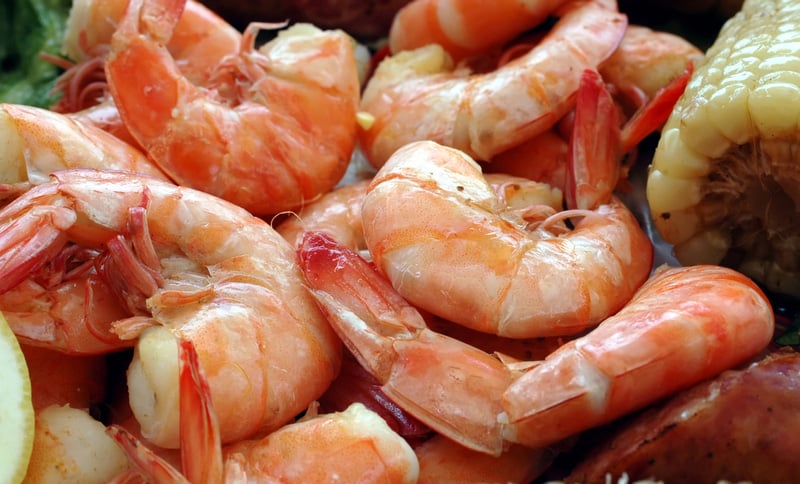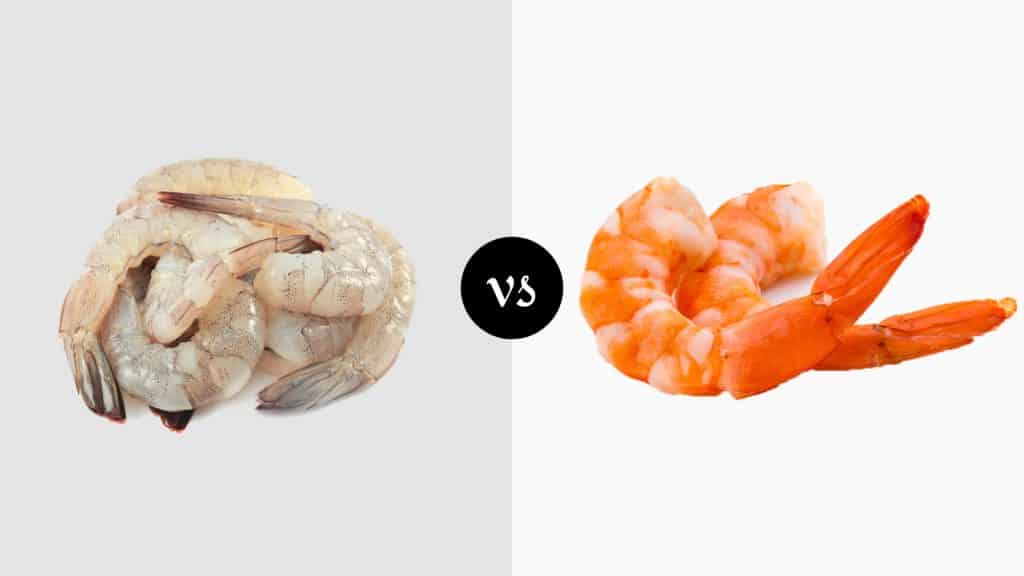
Shrimp are among the world’s most famous and popular seafood. They are enjoyed in multiple dishes and part of various cuisines from all around the world. Rich in omega-fortified fatty oils and vitamins, they are also one of the healthiest types of seafood around.
Easy to find and mild in flavor, shrimps can be used both raw and cooked. Yet, it’s not only buying them raw or cooked for cooking that’s possible. As startling as the idea of eating raw shrimps may seem, certain individuals do take a risk and enjoy the taste.
We’ve got all the differences between raw vs. cooked shrimp coming up. Our comparison covers everything a cook needs to know about these two widely used ingredients.
Raw Vs. Cooked Shrimp Comparison
| Raw Shrimp | Cooked Shrimp | |
|---|---|---|
| Cuisine | Japanese, Chinese, Asian | Global Cuisine |
| Color | White With Definite Transparency & Vivid Hues | Light Pink When Perfectly Cooked, Matte White To Gray When Overcooked |
| Flavor | Boldly Sweet, Pure Shrimp Flavor With Intense Ocean Richness | Mildly Sweet Shrimp Flavor With Umami Ocean Richness |
| Uses | Consumed Raw As Asian Delicacy To Enjoy Head Juices (Shrimp Hepatopancreas) - Eating Raw Is Extremely Dangerous, Cooking Almost Always Recommended | Only Served Raw In Sushi And After Exact Preparation | Cook Shrimp From Raw For Best Potential Flavor | All-Purpose Versatility - Add To Quick Cooking Meals |
| Benefits | Cleaner, Stronger, Sweeter, Purer Flavor When Cooking/Eating Shrimp From Raw | Generally Always Safe To Eat, Fantastic Time-Saving Ingredient |
| Considerations | Shrimp Can Contain Over 70 Types Of Bacteria - Consuming Raw Shrimp Can Be Life-Threatening | Anaphylactic Allergies Common | Avoid All Raw Seafood If A Young Child, Pregnant Female Or If Having History Of Allergies | Always Buy The Freshest Shrimp Possible Otherwise Opt For Frozen If Uncertain | Don’t Cook Precooked Shrimp For More Than 15 Minutes - Overcooking Turns Shrimp White To Gray And Ruins Flavor & Texture |
| Affordability | $7-$25 Per Pound | $7-$25 Per Pound |
Raw vs Cooked Shrimp
Trying to decide whether you can get away with cooked shrimp or if fresh, raw shrimp is a must? Read on. From the differences between cooking times to flavor, suitability, and affordability, the upcoming wrap-up has all the info necessary to help you choose.
Raw Shrimp
Always procure fresh shrimps. Don’t buy from vendors who hoard seafood and then sell old shrimps and prawns. Like all seafood, they’re best enjoyed fresh. If you’re buying from a supermarket, get frozen shrimp but never try defrosting frozen shrimps on the counter.
Always leave them in the refrigerator overnight and start cooking the next day after cleaning them properly by soaking them in water, salt, and vinegar and then giving them a wash.
Remove the stomach and get rid of all traces of sand and dirt that is likely harboring toxins and bacteria.
Cuisine
Raw shrimps are widely enjoyed in certain parts of the world. Japanese cuisine has a fondness for raw shrimp. They are consumed in some parts of China as well.
Even though seafood is relished in Europe and the rest of the world, the vast majority of chefs do not recommend eating raw shrimp at all due to the risk of contracting Vibriosis and thus suffering from food poisoning.
Color
Fresh raw shrimp should be white with a degree of transparency. All colors and hues should be vivid instead of dull. Dull colors, a slimy texture, and an off smell are all sure signs that your raw shrimp are bad. Eating spoiled shrimp can be deadly.
Cooking raw shrimps can be tricky if it’s one of your first times. Knowing when they’re done takes monitoring the color. As soon as they turn from white to bright pink, turn off the stove. Your shrimp are done.
Flavor
Expect a boldly sweet shrimp flavor when eating raw shrimp that’s bolder in underlying ocean taste and at the same time purer and stronger in sweetness.
When shrimp heads are eaten as a delicacy, one is consuming shrimp hepatopancreas, which is the main digestive and secretory organ of the creature.
The juice emerging from biting into a shrimp head tastes like tomalley, which is a sauce made from lobster liver, or a very intense lobster taste that’s high in fishy richness, saltiness, and sweetness.
Uses
The first and foremost use of raw shrimp is for cooking, not uncooked consumption. All seafood is best consumed fresh – the fresher, the better.
Fresh raw shrimp are only suitable for eating uncooked if they’re extremely fresh (within hours) or treated with a mild acid marinade like something including citrus or vinegar. Sushi chefs ensure that all the parasites present in raw shrimp are dead before serving it.
Furthermore, in many parts of Asia, including China, Japan, and Hong Kong, the fluid inside a shrimp’s head is considered a high-priced delicious delicacy.
The Amaebi variety of northern shrimp native to the Pacific waters surrounding Canada is the only shrimp species consumed uncooked. Also known as spot prawns, amaebi are extremely sweet, and cooking them detracts from this pure, sweet flavor.
Other types of prawns can be consumed raw when fresh, cleaned, and confirmed as free from bacteria by a qualified sushi chef or culinary seafood expert.
Benefits
Raw shrimp’s main benefit is that you get a much cleaner, stronger, sweeter flavor regardless of whether you’re risking it and eating it raw or cooking your shrimp fresh. There’s no better way to ensure that your meal comes out tasting as good as possible.
They also absorb far more flavor. Another benefit to buying raw shrimp is that you get to deshell them yourself, which ensures cleanliness, and it gives you a tasty ingredient to make prawn stock from.
Considerations
Shrimp, like most seafood, harbors a lot of unhealthy bacteria. The primary reason for cooking shrimp and other seafood first is to kill the latent bacteria and parasites, and there are over 70 different varieties present in the average shrimp.
Raw shrimp might seem tempting, but you’ve got every reason to be careful. It can cause severe food poisoning if the prawns are guaranteed to be just-out-the-water fresh and haven’t been cleaned properly.
One wrong shrimp and your seafood dinner night might land you in the E.R. Shrimp-induced anaphylactic allergies are very common, with a string of potential side effects arising. Some individuals might suffer from severe skin issues such as a breakout of welts or hives.
Nasal congestion, shortness of breath, and even loss of consciousness are possible in severe cases. Others might experience mild symptoms like tingling inside the mouth or swollen lips, which can result in a completely swollen face if the allergic reaction is too severe.
Pregnant women, young children, and individuals with a history of allergies should avoid indulging in the world of uncooked seafood completely. Among other bacteria, salmonella, often present in prawns and other meat and seafood, can be deadly.
Always procure fresh shrimps. Don’t buy from vendors who hoard seafood and then sell old shrimps and prawns. Like all seafood, they’re best enjoyed fresh. If you’re buying from a supermarket, get frozen shrimp but never try defrosting frozen shrimps on the counter.
Always leave them in the refrigerator overnight and start cooking the next day after cleaning them properly by soaking them in water, salt, and vinegar and then giving them a wash. Remove the stomach and eliminate all traces of sand and dirt that is likely harboring toxins and bacteria.
Affordability
Raw shrimp cost more than cooked shrimp because fresh shrimp are harder to keep unspoiled for extended durations. The price of raw shrimp depends on whether they’re obtained fresh or frozen. Shrimp size and the degree of cleaning also affect the price.
On average, raw shrimp retail for between $7 and $25 per pound.
Cooked Shrimp
Cooked shrimp, or rather pre-cooked shrimp, is a tasty time-saving ingredient that comes out great if you take care not to reheat it too much. Let’s take a closer look at the flavor highlights, tips, and more about cooked shrimp and how to handle it.
Cuisine
Cooked shrimp are used throughout countless forms of regional cuisine. Shrimp is popular throughout North America, Asia, and Europe. Japan consumes the most shrimp per capita, followed by the USA and then Europe.
Color
Perfectly cooked shrimp will turn an opaque light but bright pink color with a shimmering translucency to its shine. Overcooked shrimp turn a dull, deep white and extremely overcooked shrimp are gray.
Flavor
Anyone familiar with shrimp will know its sweet, rich flavor well. Pre-cooked shrimp packs less flavor than freshly cooked shrimp. The favorable flavor notes, sweetness, and richness are subdued when using pre-cooked shrimp.
Pre-cooked shrimp also absorbs less flavor from the cooking process and other ingredients than shrimp cooked from raw. Cooking pre-cooked shrimp for too long results in a dry texture and somewhat flavorful shrimp flesh
Uses
Pre-cooked shrimp are excellent for quick meals and as an additional ingredient in pasta and noodle meals that need a little extra substance. Try adding pre-cooked shrimp directly to salads or grains. They’re great in soups, whether hot or cold.
Use pre-cooked shrimp flesh in spring rolls, wraps, and sandwiches. Essentially, you can use pre-cooked shrimp in any of the ways that you would use fresh raw shrimp. Just make sure that you don’t cook it for as long.
Benefits
The only benefit to precooked shrimp is that you know they’re safe for consumption, and they save a lot of time when preparing food.
Considerations
Never cook pre-cooked shrimp for more than 15 minutes, or you’ll sap all of the flavors and ruin its texture, turning it into a chewy, tasteless food item instead of a sweet, flavorful delicacy.
Watch the color of the flesh carefully as soon as a matt white coloring starts developing, your pre-cooked shrimp have seen enough heat. Too long, and the entire prawn will turn from pink to white, and that’s precisely what you don’t want.
Affordability
Pre-cooked shrimp don’t spoil very quickly and are therefore far cheaper than raw shrimp. Most pre-cooked shrimp retail for around $6 to $25 per pound
Why Is Raw Shrimp More Expensive Than Cooked?
Raw shrimp has an extremely limited shelf life. At a certain point, raw shrimp will need to be frozen, which detracts from the flavor and the price. Large raw shrimp are in constantly high demand, whereas small shrimp are in abundance and are hard to store.
The vast majority of establishments sell small varieties of cooked shrimp for far less than equal quantities of raw shrimp. However, large cooked shrimp cost more than equally sized raw shrimp because shrimp lose roughly 20% of their weight while cooking.
The cooked shrimp also carry the additional labor costs of cleaning, preparation, and cooking.
What Is The Difference Between Raw And Cooked Shrimp?
The main difference between raw and cooked shrimp is that raw shrimp are unsafe for consumption without cooking while offering the best potential flavor and texture when cooked from fresh, whereas cooked shrimp is supplied pre-cooked and supplies a tradeoff of time-saving convenience at the cost of superior taste.
Which Is Best Between Raw Vs. Cooked Shrimp?
Ultimately, when it comes to picking a winner between raw vs. cooked shrimp, fresh shrimp always wins due to how much better all seafood tastes when prepared as fresh as possible.
The only consideration to keep in mind for both varieties is that some people believe that farm-raised shrimps are unhealthy due to being fed too many antibiotics. Ultimately, there’s nothing like the naturally occurring shrimps thriving out at sea.
They grant the best flavor and are the safest.
